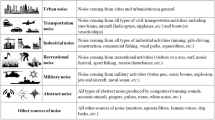Abstract
In this article, we introduce, characterize and apply an extended version of the Birnbaum–Saunders model based on the Mudolkar–Hutson skew distribution. This model is appropriated for describing phenomena involving accumulation of some type, as is the case of environmental contamination. Specifically, we find the density, distribution function, and moments of the new model. In addition, we derive several properties and transformations related to this distribution. Furthermore, we propose an estimation method for the parameters of the model. Moreover, we conduct a study of its hazard rate focuses in environmental analysis. A computational implementation in R language of the obtained results is discussed. Finally, we present two examples with real data from environmental quality in Chile that illustrate the proposed methodology.





Similar content being viewed by others
References
Aarset MV (1987) How to identify a bathtub shaped hazard rate? IEEE Trans Reliab 36:106–108
Balakrishnan N, Leiva V, Sanhueza A, Cabrera E (2009a) Mixture inverse Gaussian distribution and its transformations, moments and applications. Statistics 43:91–104
Balakrishnan N, Leiva V, Sanhueza A, Vilca F (2009b) Estimation in the Birnbaum–Saunders distribution based on scale-mixture of normals and the EM-algorithm. Stat Oper Res Trans 33:171–192
Birnbaum ZW, Saunders SC (1968) A probabilistic interpretation of Miner’s rule. SIAM J Appl Math 16:637–652
Birnbaum ZW, Saunders SC (1969a) A new family of life distributions. J Appl Probab 6:319–327
Birnbaum ZW, Saunders SC (1969b) Estimation for a family of life distributions with applications to fatigue. J Appl Probab 6:328–347
Cox DR, Oakes D (1984) Analysis of survival data. Chapman and Hall, London
Gokhale S, Khare M (2004) A review of deterministic, stochastic and hybrid vehicular exhaust emission models. J Transp Manag 2:59–74
Gómez HW, Olivares-Pacheco JF, Bolfarine H (2009) An extension of the generalized Birnbaum–Saunders distribution. Stat Probab Lett 79:331–338
Huang S, Qu Y (2006) The loss in power when the test of differential expression is performed under a wrong scale. J Comput Biol 13:786–97
Johnson NL, Kotz S, Balakrishnan N (1995) Continuous univariate distributions—vol 2. Wiley, New York
Kass R, Raftery A (1995) Bayes factors. J Am Stat Soc 90:773–795
Lee L, Helsel D (2005) Statistical analysis of water-quality data containing multiple detection limits: S-language software for regression on order statistics. Comput Geosci 31:1241–1248
Leiva V, Hernández H, Riquelme M (2006) A new package for the Birnbaum–Saunders distribution. R Journal 6:35–40. http://www.R-project.org/doc/Rnews/Rnews_2006-4.pdf
Leiva V, Barros M, Paula GA, Sanhueza A (2008) Generalized Birnbaum–Saunders distributions applied to air pollutant concentration. Environmetrics 19:235–249
Leiva V, Sanhueza A, Angulo JM (2009a) A length-biased version of the Birnbaum–Saunders distribution with application in water quality. Stoch Environ Res Risk Assess 23:299–307
Leiva V, Barros M, Paula GA (2009b) Generalized Birnbaum–Saunders models using R. Brazilian Statistical Association, São Paulo, Brazil (in English)
Leiva V, Sanhueza A, Saunders SC (2009c) New developments and applications on life distributions under cumulative damage. CIMFAV Technical Report No. 2009.01. http://www.cimfav.cl/reports.html#2009
Leiva V, Vilca F, Balakrishnan N, Sanhueza A (2010) A skewed sinh-normal distribution and its properties and application to air pollution. Comm Stat Theor Methods 39:426–443
Marshall AW, Olkin I (2007) Life distributions. Springer, New York
Miner MA (1945) Cumulative damage in fatigue. J Appl Mech 12:159–164
Mudholkar GS, Hutson AS (2000) The epsilon-skew-normal distribution for analyzing near-normal data. J Stat Plan Inference 83:291–309
Podlaski R (2008) Characterization of diameter distribution data in near-natural forests using the Birnbaum–Saunders distribution. Can J For 18:518–527
Owen WJ (2006) A new three-parameter extension to the Birnbaum–Saunders distribution. IEEE Trans Reliab 55:475–479
R Development Core Team (2008) R: a language and environment for statistical computing. R Foundation for Statistical Computing, Vienna, Austria
Rieck JR, Nedelman JR (1991) A log-linear model for the Birnbaum–Saunders distribution. Technometrics 33:51–60
Saunders SC (1974) A family of random variables closed under reciprocation. J Am Stat Soc 69:533–539
Saunders SC (2007) Reliability, life testing and prediction of services lives. Springer, New York
Spiegelhalter DJ, Best NG, Carlin BP, van der Linde A (2002) Bayesian measures of model complexity and fit. J R Stat Soc B 64:1–34
Acknowledgements
The authors wish to thank the referees for their helpful comments that greatly improved this article. This study was partially supported by a FAPESP grant from Brazil and by DIPUV 29-2006, FONDECYT 1080326, FONDECYT 1090265 and DIUFRO 080061 grants from Chile.
Author information
Authors and Affiliations
Corresponding author
Rights and permissions
About this article
Cite this article
Vilca, F., Sanhueza, A., Leiva, V. et al. An extended Birnbaum–Saunders model and its application in the study of environmental quality in Santiago, Chile. Stoch Environ Res Risk Assess 24, 771–782 (2010). https://doi.org/10.1007/s00477-009-0363-6
Published:
Issue Date:
DOI: https://doi.org/10.1007/s00477-009-0363-6




